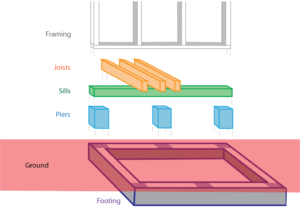While any homeowner is accustomed to looking for visible problems in and out of the house—broken siding, damaged flooring, a leaky ceiling—problems with a home’s foundation may not be as obvious. It’s crucial to be able to recognize when your foundation is failing, so you can catch a small problem before it becomes a big one.

While most of your foundation isn’t readily visible, you can recognize common problems with your foundation from a careful inspection of what you are able to see inside your home.
- Sagging floors. When you drop a ball on the floor, does it quickly roll to a specific corner? Is there a part of your floor that squeaks, or seems to have more “give” than the rest of the room? This is a sign of possible damage to your foundation.
- Bulging walls or floors. Damaged sills or joists will sag, and this sagging can cause a wall to bulge out or floorboards to buckle. If you find you’re suddenly tripping over parts of your floor that used to be just fine, the cause could be your foundation.
Both these problems could be due to joists or sills that have weakened due to water or termite damage, and are now sagging or even broken. Another possible cause is piers that are cracked or sinking, which means they’re no longer adequately supporting the sills.
Fortunately, an inspection by a qualified foundation professional can locate the cause of such problems fairly quickly. You can also easily check your own piers for cracks or other damage. Sometimes a simple repair will solve the problem completely, and help you avoid costly repairs to your floors, walls, and other parts of your home.
Richard Earls Construction specializes in finding the cause of such problems and offering a professional solution. Give us a call and ask how we can help you with your foundation.
